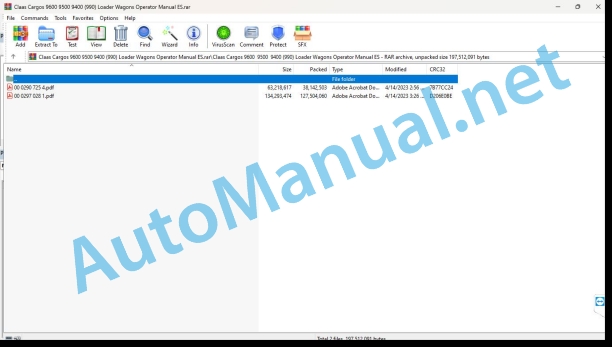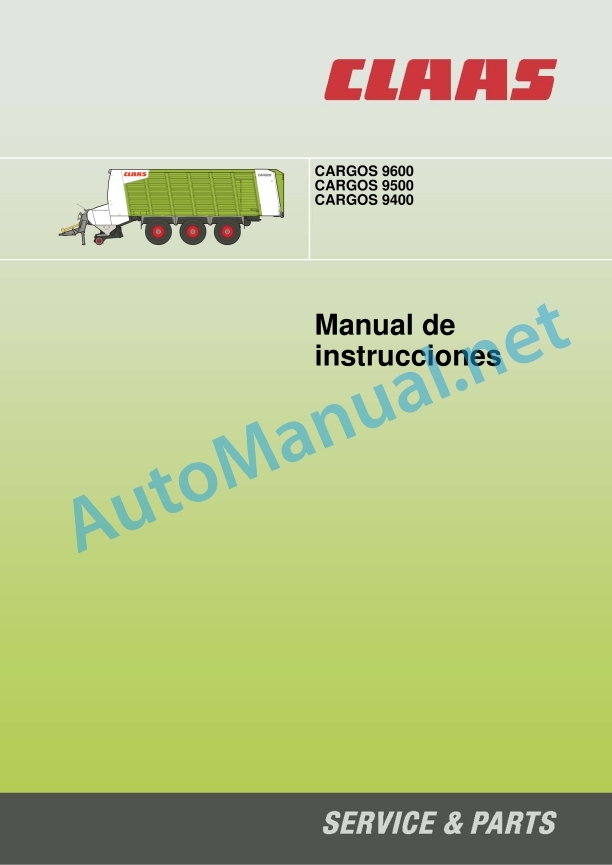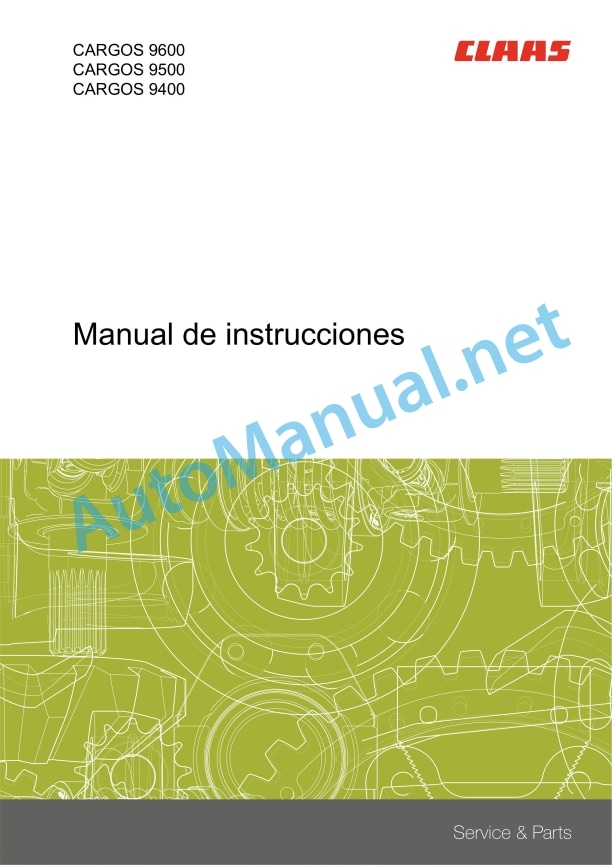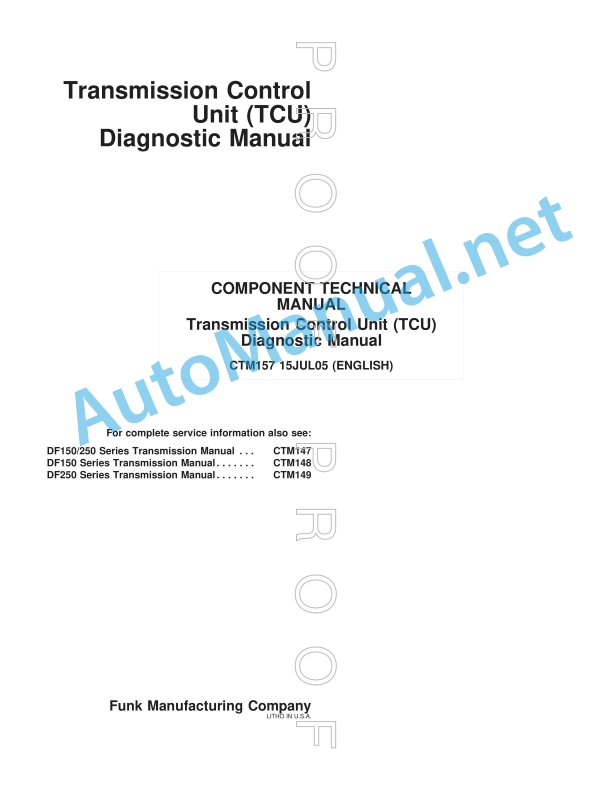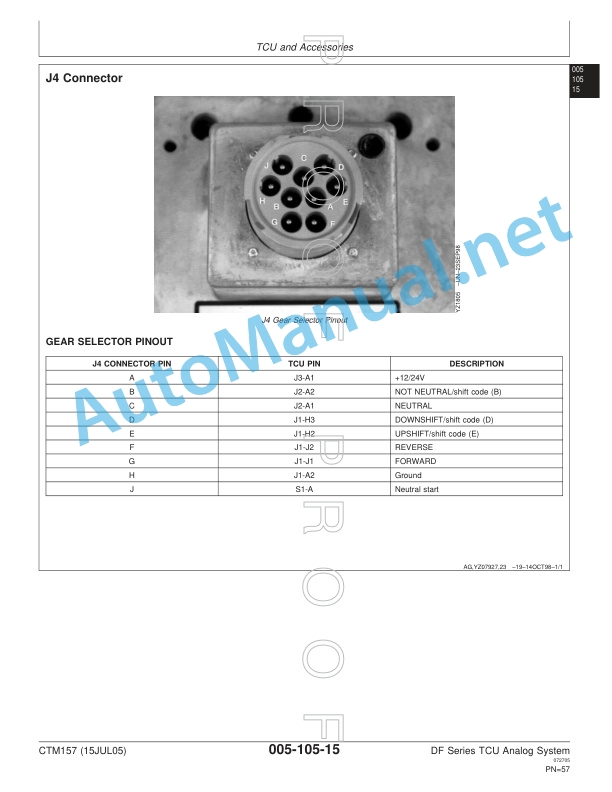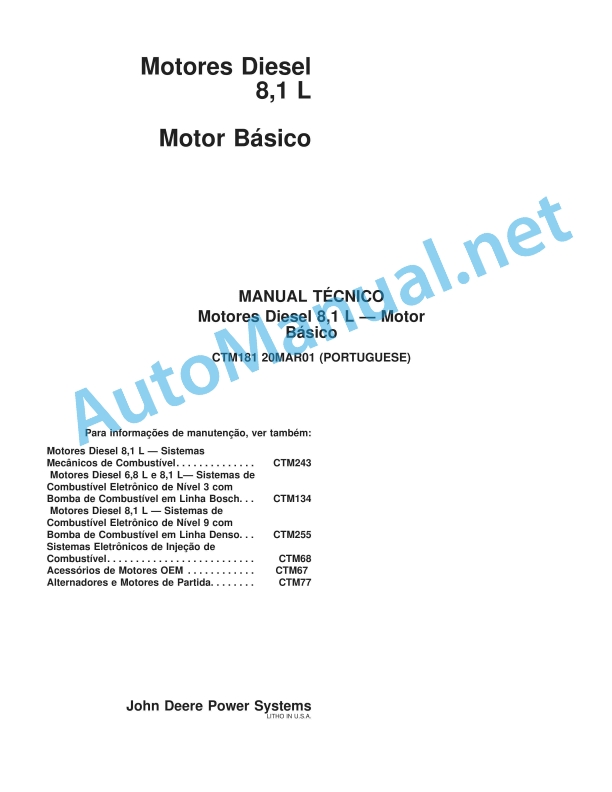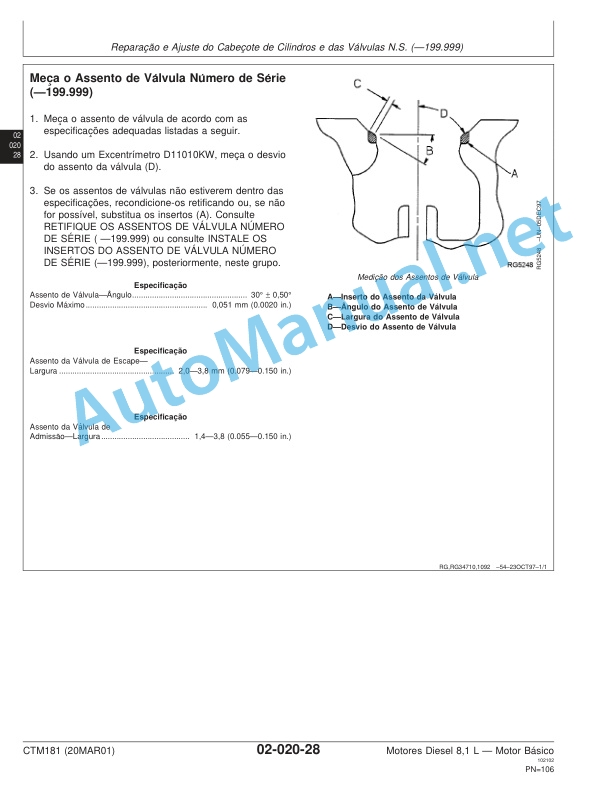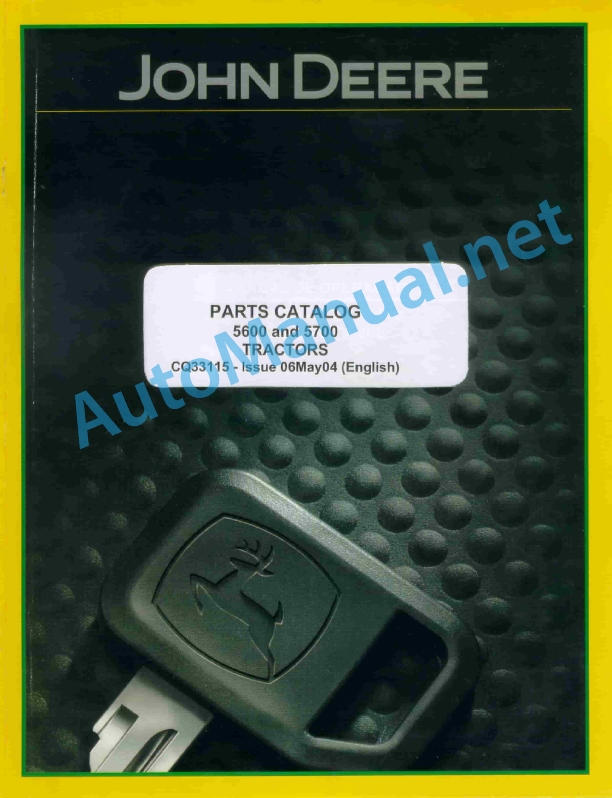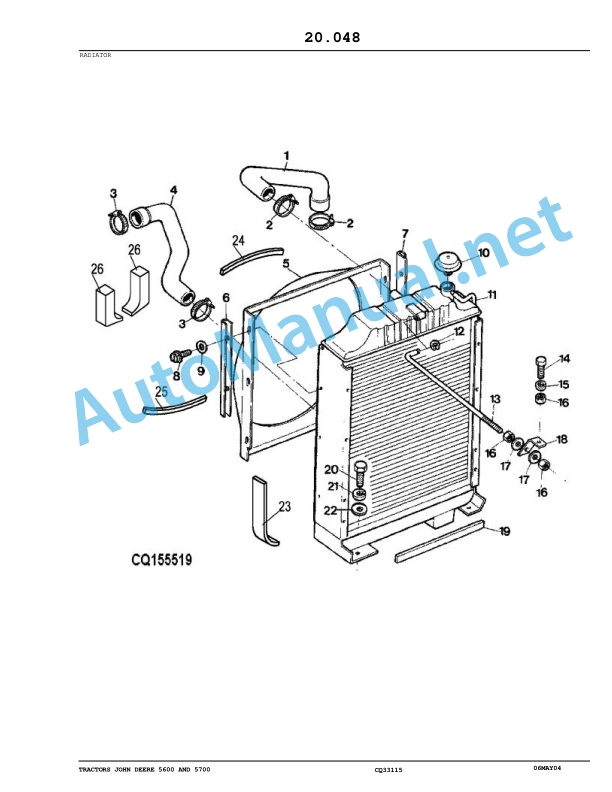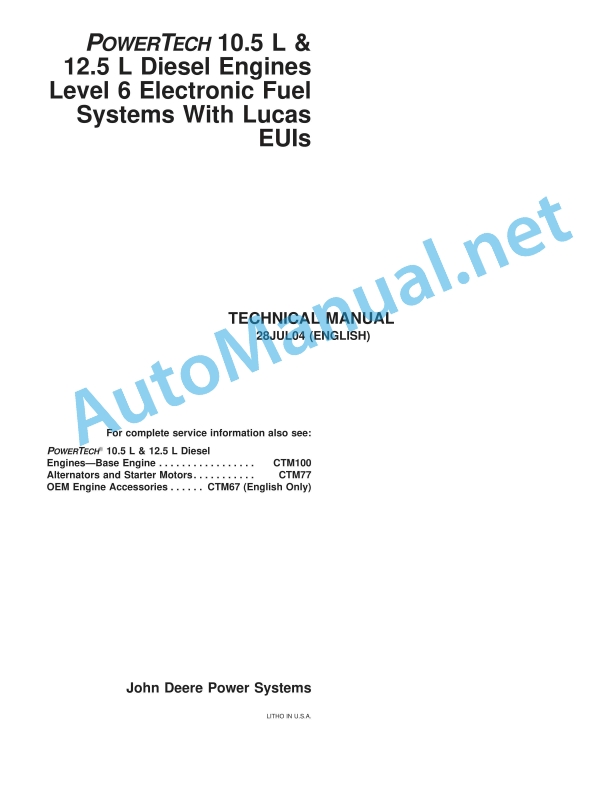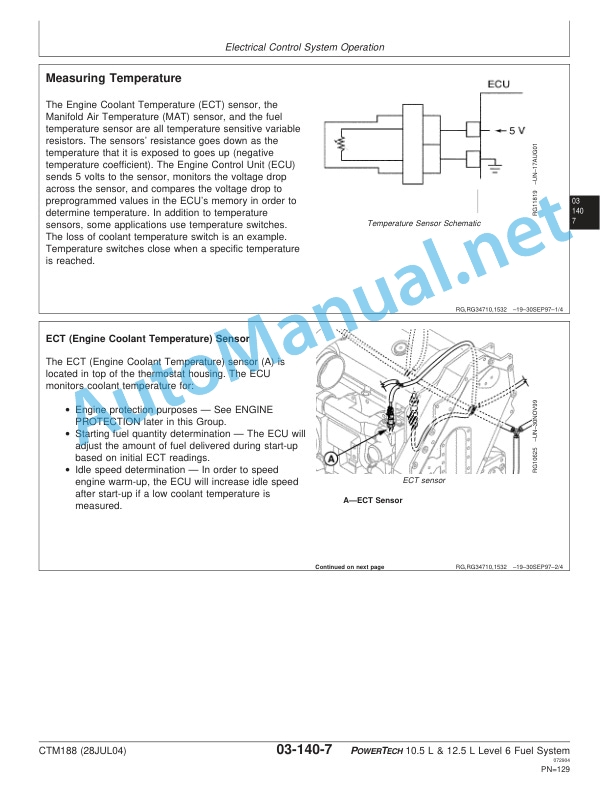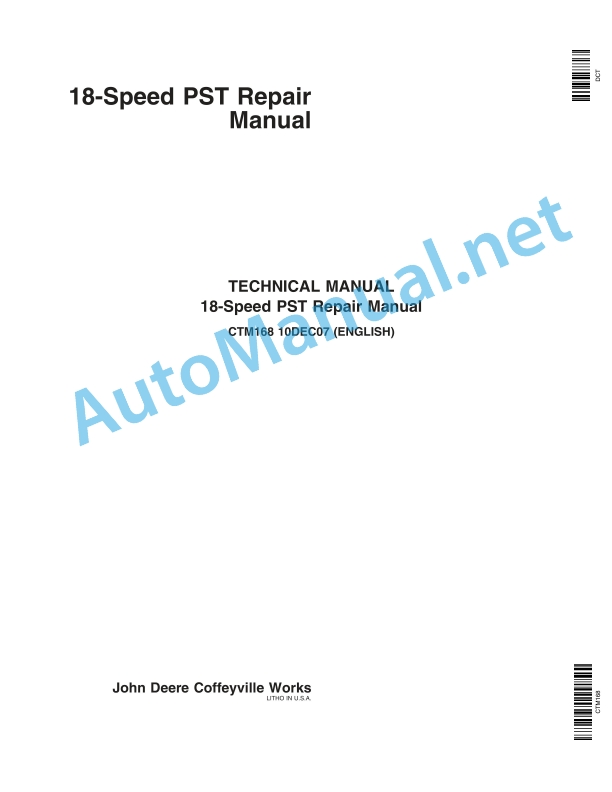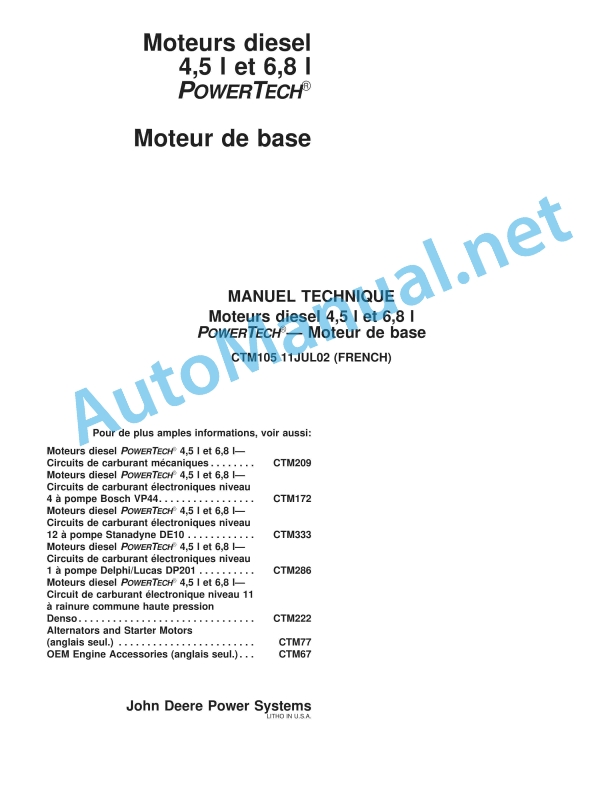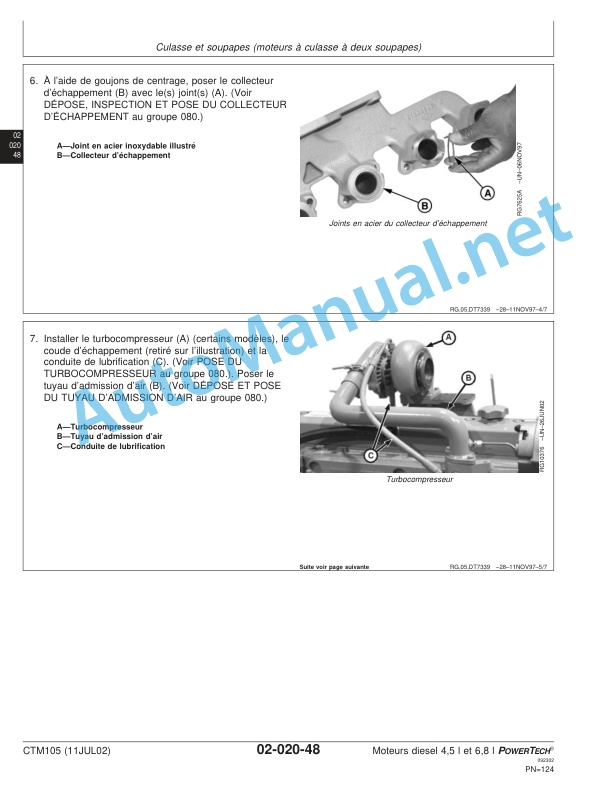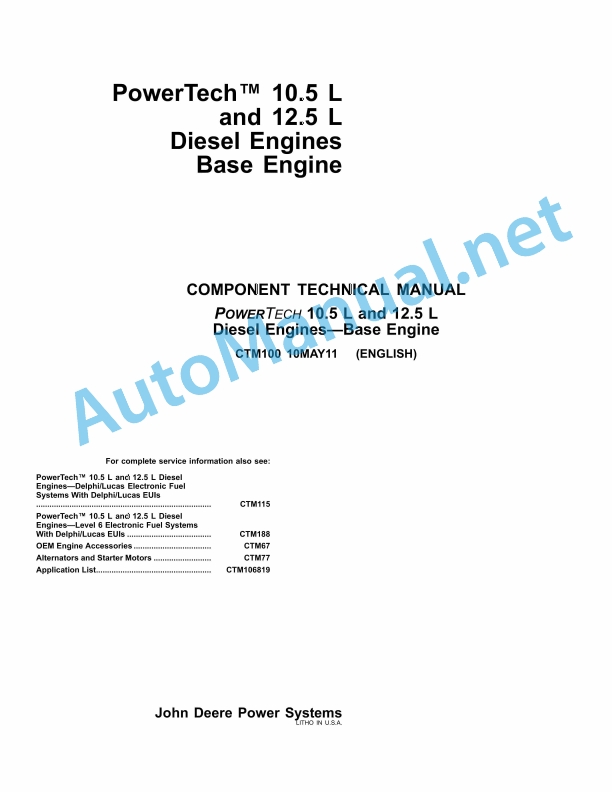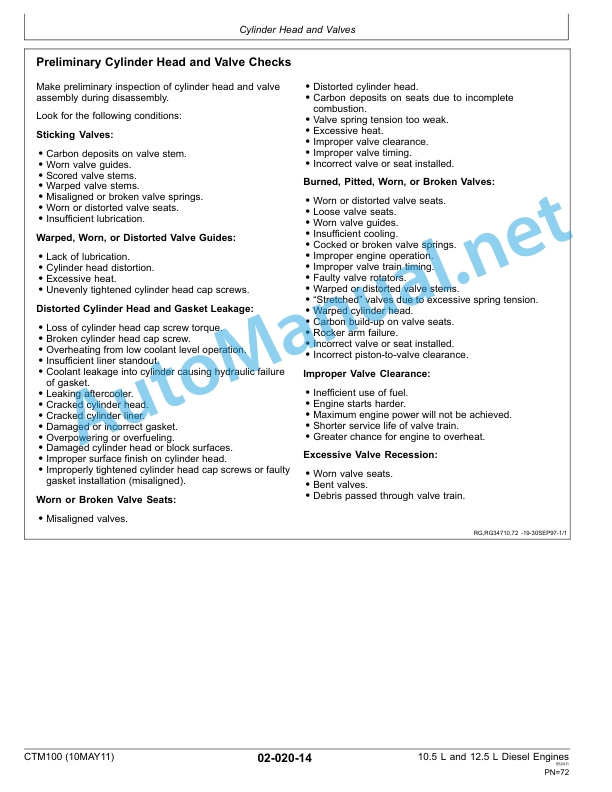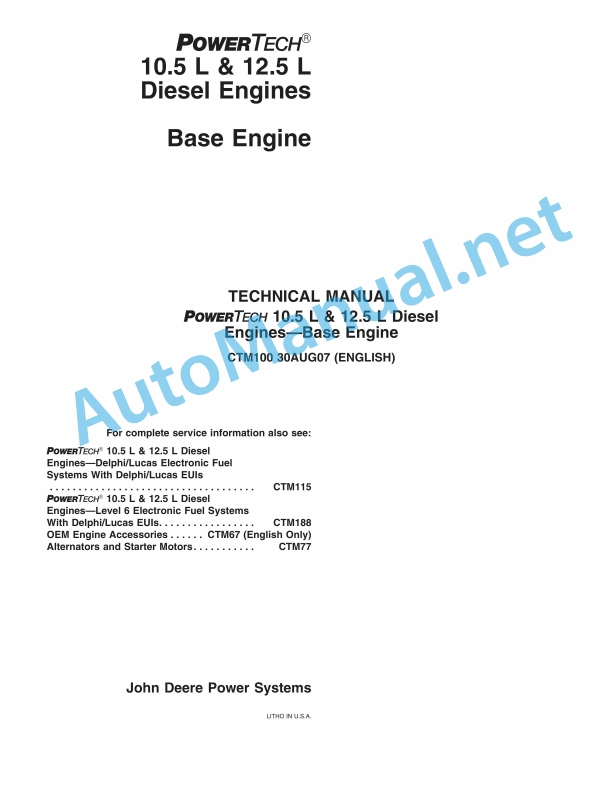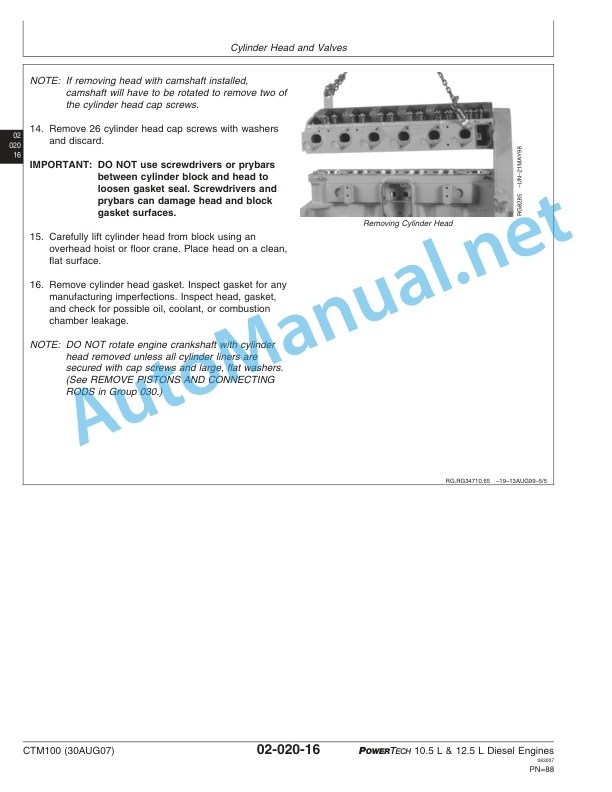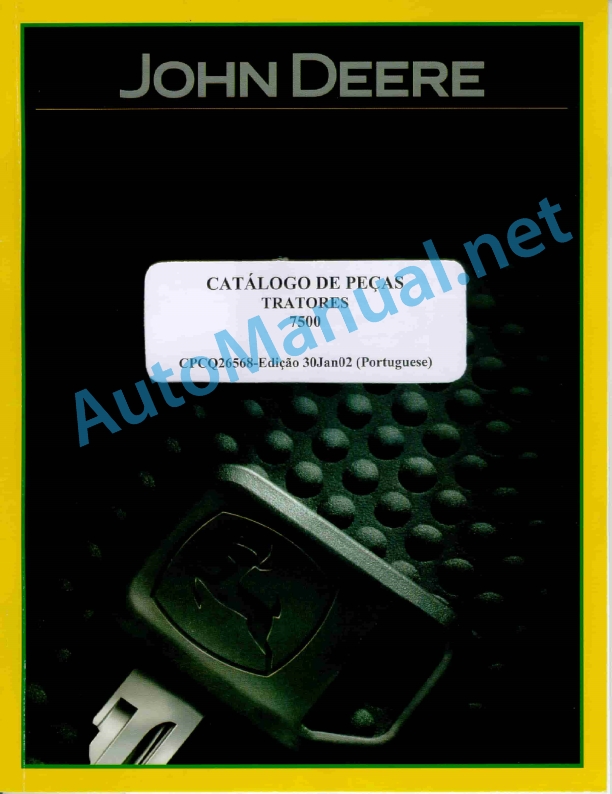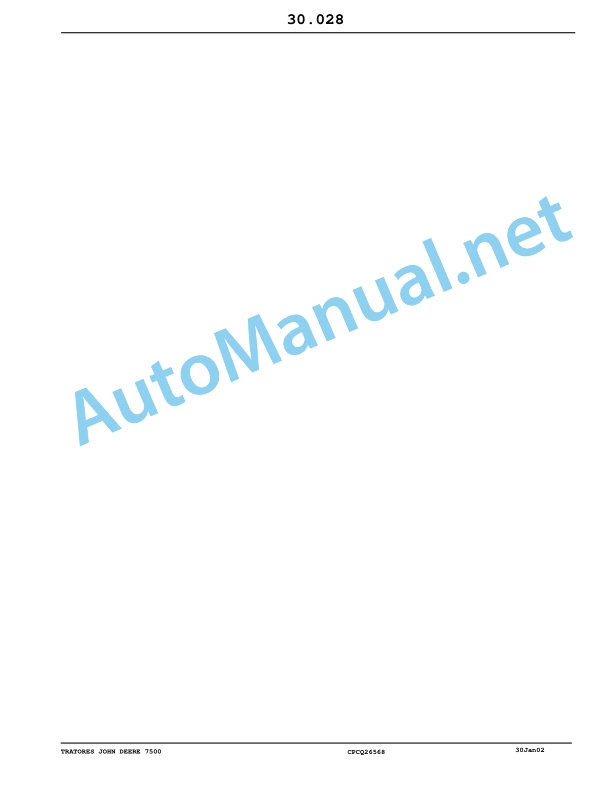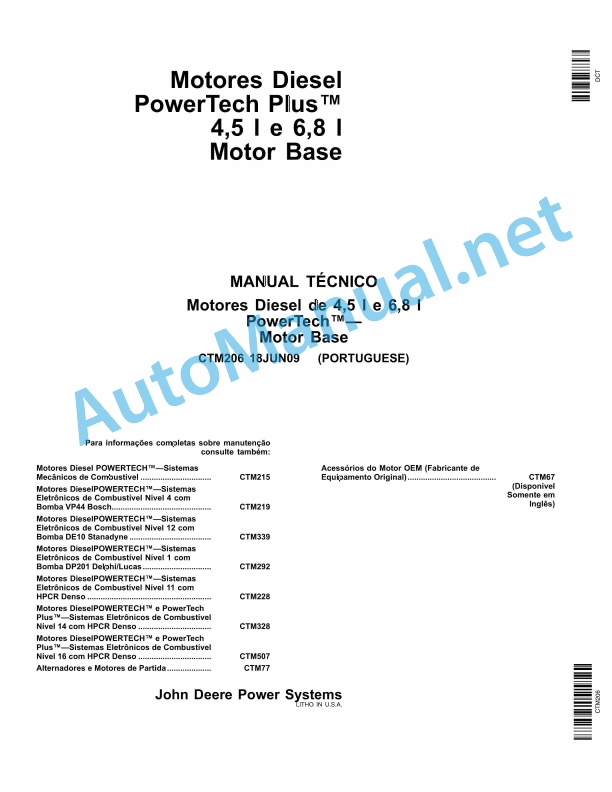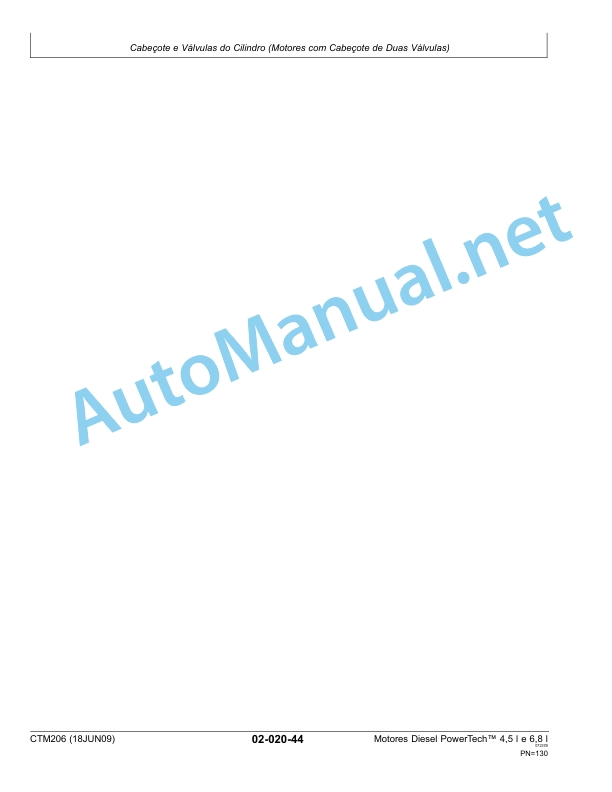Claas Cargos 9600 9500 9400 (990) Loader Wagons Operator Manual ES
$50.00
- Model: Cargos 9600 9500 9400 (990) Loader Wagons
- Type Of Manual: Operator Manual
- Language: ES
- Format: PDF(s)
- Size: 158 MB
File List:
00 0290 725 4.pdf
00 0297 028 1.pdf
00 0290 725 4.pdf:
CHARGES 9600
CHARGES 9500
CHARGES 9400
1 Regarding this instruction manual
1.1 Information regarding the instruction manual
1.1.1 General instructions
1.1.2 Validity of the manual
1.1.3 Technical instructions
1.1.4 Symbols and indications
1.1.5 Handling of the manual
Direction signs
2 Security
2.1 Safety instructions
2.1.1 To take special account
2.1.2 Qualification of piloting and maintenance personnel
2.1.3 Proper machine application
2.1.4 Logically foreseeable inappropriate application
2.1.5 Protection and safety standards at work
2.1.6 First aid measures
2.1.7 Risk of injury from hydraulic fluids
2.2 Safety instructions on the machine
2.2.1 Warning symbols
2.2.2 Position of warning symbols
3 Machine Description
3.1 Summary and operation
3.1.1 Combined trailer with tridem axle set
3.1.2 Combined trailer with tandem axle set
3.1.3 Machine operation
Loading and silage trailer operating mode
Transport trailer operating mode
3.2 Access to the workplace and maintenance points
3.2.1 Loading area
3.3 Optional machine equipment
3.3.1 Hydraulic coupling ISO 16028
3.3.2 Joint fork
3.3.3 Rear part with dismantled metering rollers
3.3.4 Channel coverage
3.3.5 Cutting trailer transformation kit
3.3.6 Pick-up: Additional feeler wheel
3.3.7 Central lubrication system
3.3.8 Fill level sensor
3.3.9 Replacing blind knives
3.3.10 PROFI CAM 3
3.3.11 Work lighting
3.3.12 LED work lighting
3.3.13 Side signaling lights
3.3.14 Battery cable
3.3.15 Order printer for ISOBUS
3.3.16 Load weight display
3.3.17 Download depending on the turning moment
3.4 Identification plates and identification numbers
3.4.1 Spare parts and technical questions
3.4.2 Identification plate position
3.4.3 Identification number position
3.4.4 Machine identification plate explanation
4 Control and display instruments
4.1 External control cell
4.1.1 Articulated lance and cutting tray
4.2 Indicator elements
4.2.1 Forced direction manometer
4.2.2 Forced direction manometer
4.2.3 Ball tap
4.2.4 Pick-up discharge pressure gauge*
4.2.5 PROFI CAM 3 Monitor*
4.3 CLAAS COMMUNICATOR
4.3.1 Summary
4.4 ISOBUS control
4.4.1 Screen
4.4.2 Title bar
4.4.3 Menu bar
4.4.4 Data field
4.4.5 Status bar
4.4.6 Softkey
4.4.7 Softkey Summary
Transport menu
Load menu
Submenu Load – automatic operation
Submenu Load – manual operation
Download menu
Submenu Download – automatic operation
Submenu Download – manual operation
4.4.8 Program version
5 Technical data
5.1 CHARGES 9600 – type 990
5.1.1 Measurements
5.1.2 Weights
5.1.3 Pick-up
5.1.4 Cutting mechanism
5.1.5 Tire air pressure
5.1.6 Requirements for the tractor
5.1.7 Electrical installation
5.1.8 PTO shaft speed
5.1.9 Acoustic intensity level
5.1.10 Lubricants
5.2 CHARGES 9500 – type 990
5.2.1 Measurements
5.2.2 Weights
5.2.3 Pick-up
5.2.4 Cutting mechanism
5.2.5 Tire air pressure
5.2.6 Requirements for the tractor
5.2.7 Electrical installation
5.2.8 PTO shaft speed
5.2.9 Acoustic intensity level
5.2.10 Lubricants
5.3 CHARGES 9400 – type 990
5.3.1 Measurements
5.3.2 Weights
5.3.3 Pick-up
5.3.4 Cutting mechanism
5.3.5 Tire air pressure
5.3.6 Requirements for the tractor
5.3.7 Electrical installation
5.3.8 PTO shaft speed
5.3.9 Acoustic intensity level
5.3.10 Lubricants
6 Preparation of the machine
6.1 Turn off the machine and secure it
6.1.1 Turn off the machine and secure it
6.2 Assemble the machine
6.2.1 Supply package summary
6.2.2 Removing individual parts from the load space
Open the access hatch
Close the access hatch
6.2.3 Save the ladder
6.2.4 Save the shims
6.2.5 Mount the cardan shaft to the machine
6.2.6 Connect the ISOBUS cable
6.2.7 Assemble optional machine equipment
6.3 Access to jobs and maintenance positions
6.3.1 Access the cargo space
6.3.2 Leaving the cargo space
6.4 Adapt the tractor
6.4.1 Forced steering hitch
6.4.2 Adapt the tractor’s pneumatic brake equipment
6.4.3 Mounting the support for CLAAS COMMUNICATOR
6.4.4 Assembling the CLAAS COMMUNICATOR
6.5 Adapt the machine
6.5.1 Adjust forced steering
6.5.2 Use as a transport trailer
6.5.3 Dismantle the charging and cutting assembly
Uncouple / couple the central lubrication system*
6.5.4 Dismantling the metering roller unit
6.5.5 Assembling the blind knife set*
6.5.6 Attach the hydraulic hoses
Closed hydraulic system (Load Sensing) with Load Sensing control line:
Open hydraulic system or closed hydraulic system without control line Load Sensing:
Attach the hydraulic hose (P1)
6.5.7 Adapt the hydraulic system
Closed hydraulic system (constant pressure or Load Sensing)
Open hydraulic system (standard system)
6.5.8 Adjusting the hydraulic articulated drawbar
6.5.9 Adjust the hydropneumatic chassis
6.5.10 Central lubrication system*: Fill the lubricant tank
6.6 Hooking the machine to the tractor
6.6.1 General instructions
6.6.2 Connect the cable for advance lighting
6.6.3 Mount the ISOBUS cable
6.6.4 Attach the lance
6.6.5 Place the support leg upwards
6.6.6 Engage forced steering
Basic setting
Adapt the drawbar
Attach the drawbar
Forced steering crash protection
6.6.7 Forced steering: Check hydraulic pressure
6.6.8 Cardan shaft: check the length
Cardan shaft – shortest operating position
Cardan shaft – longest operating position
6.6.9 Cardan shaft: adapt the length
6.6.10 Assemble the cardan shaft
6.6.11 Connect the pneumatic brake
6.6.12 Connect the hydraulic brake
6.6.13 Apply the parking brake
6.6.14 Remove the chocks
6.7 Uncoupling the machine from the tractor
6.7.1 Warnings to take into account
6.7.2 Chock the chocks
6.7.3 Apply the parking brake
6.7.4 Disengaging forced steering
6.7.5 Remove the support leg
6.7.6 Unhook the lance
6.7.7 Dismantle the cardan shaft
6.7.8 Unplug the electrical installation
6.7.9 Dismantling the CLAAS COMMUNICATOR
6.7.10 Remove the ISOBUS cable
6.7.11 Uncouple the hydraulic pipes
6.7.12 Disengaging the pneumatic brake
6.7.13 Disengaging the hydraulically operated brake
6.8 Load the machine and tie it down
6.8.1 Load the machine and tie it down
7 Management
7.1 Driving with the combined trailer
7.1.1 Check before the trip
7.1.2 Ladder: Insert the support
7.1.3 Activate the hydraulic damping of the drawbar
7.1.4 Raise and lower the elevator shaft
7.1.5 Maneuvering the trailer combined with a tractor without a pneumatic brake system
7.1.6 Lock the tracking steering axis
7.2 Driving on the road
7.2.1 General instructions
7.2.2 Types of license required for Germany
7.2.3 Documentation that must be carried
7.2.4 Modifications to the machine
7.2.5 Registration obligation and signage obligation
7.2.6 Regular checks under art. 29 StVZO
7.2.7 Driving on public roads
7.2.8 Work focuses
7.3 Adjust before loading
7.3.1 Adjust before loading
7.3.2 Adjust the working height of the Pick-up
7.3.3 Adjust Pick-up Discharge*
7.3.4 Adjust the retaining plate
7.3.5 Adjust the cutting length
7.3.6 Adjust the roof sheet
7.4 loading the trailer
7.4.1 Fill the cargo space evenly
7.4.2 Charging process
7.5 Unload the trailer
7.5.1 Open the tailgate
7.5.2 Activate the deflector plate
7.6 ISOBUS control
7.6.1 Description
7.6.2 General instructions
7.6.3 Change menu
Notes on automatic operation
Change main menu
Change submenu
Leave submenus
7.7 Turn on/off the ISOBUS terminal
7.7.1 Turn on the ISOBUS terminal
Error loading the control program
7.7.2 Start the control program
7.7.3 Turn off the terminal
7.8 ISOBUS transport
7.8.1 Automatically activate transport position
7.8.2 Manually activating the transport position
7.8.3 Change the position of the articulated drawbar
7.8.4 Activate the drawbar damping
7.8.5 Raise / lower the axis
7.8.6 Lock and unlock the tracking steering axis*
7.8.7 Open/close the roof sheet
7.8.8 Turning work lighting on/off
7.9 ISOBUS loading – automatic handling
7.9.1 Open submenu Load – automatic operation
7.9.2 At the ends of the plot
Position at the ends of the plot
Work position
7.9.3 Conveyor bottom control* – loading
Torque indicator (M)
Switching on/off the automatic conveyor floor drive
Adapt the threshold value
Increase pressing pressure
7.9.4 Briefly connect the conveyor base
7.9.5 Raise / lower the Pickup
7.9.6 Transport channel – remove obstructions
7.9.7i level indication*
7.9.8 Indication trailer full
7.9.9 Load – end automatic handling
7.9.10 Light automation
7.10 ISOBUS loading – manual operation
7.10.1 General instructions
7.10.2 Manually load the machine
7.10.3 Open submenu Load – manual operation
7.10.4 Open/close the cutting tray
7.10.5 Increase/decrease the speed of the conveyor bottom
7.10.6 Switching on/off cargo space lighting/work lights
7.10.7 Connect/disconnect the Pickup
7.10.8 Reverse the drive of the conveyor bottom
7.10.9 Load – end manual operation
7.11 ISOBUS download – automatic handling
7.11.1 Open submenu Download – automatic operation
7.11.2 Conveyor bottom control* – download
Torque indicator (M)
Switching on/off the automatic conveyor floor drive
Adapt the threshold value
7.11.3 Connecting/disconnecting the conveyor floor drive
7.11.4 Residual emptying of the trailer (only trailers with metering rollers)
7.11.5 Increase/decrease the speed of the conveyor bottom
7.11.6 Adjust conveyor bottom control* – download
7.11.7 Download – end automatic handling
7.12 ISOBUS Download – manual operation
7.12.1 General instructions
7.12.2 Manually unload the machine
7.12.3 Open submenu Download – manual operation
7.12.4 Open/close the tailgate
7.12.5 Handle the deflector plate
7.12.6 Switching the metering roller drive on/off*
7.12.7 Download – end manual operation
7.13 ISOBUS order processing
7.13.1 Viewing order data
7.13.2 Activate / deactivate the order
7.13.3 Exit the order processing submenu
7.13.4 Create a job
7.13.5 Data entry submenu
7.14 ISOBUS settings
7.14.1 General instructions
7.14.2 Open the Settings submenu
7.14.3 Data field – submenu Settings
7.14.4 Change the threshold value, conveyor floor speed and opening angle
7.14.5 Change pressing pressure
7.14.6 Reset to factory settings
7.14.7 Saving articulated drawbar settings
7.14.8 Exit the articulated dwbasettings submenu
7.14.9 Reset the maintenance counter
7.14.10 Switching silage additive addition on/off
7.14.11 Central greasing system* – adjust greasing interval
7.14.12 Exit the settings submenu
7.15 ISOBUS information
7.15.1 General instructions
7.15.2 Open the information submenu
7.15.3 Data field – submenu information
Fault message symbols
7.15.4 Sensor mounting position
7.16 ISOBUS auxiliary function (AUX)
7.16.1 Available functions
7.16.2 Example of use
7.17 ISOBUS basic setting (initiation)
7.17.1 General instructions
7.17.2 Open the initiation submenu
7.17.3 Learn end stops
7.17.4 Download depending on the moment of rotation*
7.18 ISOBUS Drive options – Fendt
7.18.1 Use the tractor terminal
7.18.2 Terminal Tractor and Joystick
7.18.3 Joystick and CLAAS COMMUNICATOR
7.19 CLAAS COMMUNICATOR*
7.19.1 Information regarding this chapter
7.19.2 Recommendations for the most optimal use possible
7.20 Switch ooff CAS COMMUNICATOR*
7.20.1 Switching on the CLAAS COMMUNICATOR*
7.20.2 Turn off CLAAS COMMUNICATOR*
7.21 Operating CLAAS COMMUNICATOR*
7.21.1 Selection menu“ / cancel key (ESC)
7.21.2 Functional keys
7.21.3 Selection wheel – data selection and data entry
7.21.4 Text entry menu
7.21.5 Navigation in the data cell
7.21.6 Programmable keys
7.21.7 Software Support
7.22 CLAAS COMMUNICATOR* service program
7.22.1 Function set
7.22.2 Open the service program
7.23 CLAAS COMMUNICATOR* menu descriptions
7.23.1 Change the menu
7.23.2 Information menu
7.23.3 Brightness/contrast menu
7.23.4 Time and date menu
7.23.5 Memory management menu
7.23.6 Diagnostic submenu
7.23.7 Country settings menu
7.23.8 Additional function menu (AUX-O)
7.23.9 Key assignment submenu
7.24 CLAAS COMMUNICATOR* programmable keys
7.24.1 Introduction
7.24.2 Assign the key with a function
7.24.3 Clear key assignment
7.24.4 Modify the keynment
8ent and solution
8.1 Emergency management
8.1.1 Manually operate the hydraulic valves
8.2 ISOBUS error indications
8.2.1 Sensor failure
8.2.2 Indication power take-off shaft connected!
8.2.3 Search for anomalies
8.2.4 General faults
8.2.5 Error code table
8.3 Central lubrication
8.3.1 Incident and solution: central lubrication system*
9 Maintenance
9.1 Maintenance instructions
9.1.1 General instructions
9.1.2 Screws
9.1.3 Lubrication
9.1.4 Brakes
9.1.5 Wheels
9.1.6 Pipes, tubes and hoses
9.1.7 Electrical equipment
9.1.8 Pressurized air and water
9.1.9 Prevention against burns
9.1.10 Oil
9.1.11 Prevention against fires and explosions
9.1.12 Protection devices
9.1.13 Spare parts
9.2 Summary of maintenance intervals
9.2.1 Behavior with maintenance intervals
9.2.2 Before starting the harvest
9.2.3 After the first 10 hours of service
9.2.4 After the first 50 hours of service
9.2.5 Every 8 hours of service or daily
9.2.6 Every 20 hours of service
9.2.7 Every 40 hours of service
9.2.8 Every 50 hours of service
9.2.9 Every 60 hours of service
9.2.10 Every 100 hours of service
9.2.11 Every 250 hours of service
9.2.12 Every 500 hours of service or annually
9.2.13 Every 1000 hours of service or every 2 years
9.2.14 If necessary
9.2.15 After harvest
9.3 General maintenance work
9.3.1 Clean the machine
9.3.2 Maintain the machine
9.3.3 Check the fixing material
9.3.4 Eliminate crop remains
9.4 Gears
9.4.1 Check the tightness of the gear
9.4.2 Main gear: Check the oil level
9.4.3 Main gear: Change the oil
9.4.4 Rotor gear: Check the oil level
9.4.5 Rotor gear: Change oil
9.4.6 Gearing of the rear metering rollers: Change the oil
9.4.7 Upper front metering roller gear: Check oil level
9.4.8 Upper front metering roller gear: Change oil
9.4.9 Lower front metering roller gear: Check oil level
9.4.10 Front lower metering roller gear: Change oil
9.4.11 Conveyor bottom gear: Check the oil level
9.4.12 Conveyor bottom gear: Change the oil
9.5 Clutch
9.5.1 General instructions
9.5.2 Pick-up: Adjust the clutch switch
9.5.3 Check the overload clutch
9.5.4 Check the overload clutch
9.6 Cardan shaft
9.6.1 Maintain the cardan shafts
9.6.2 Remove the cardan shaft protection
9.6.3 Install the cardan shaft protection tube
9.7 Chassis
9.7.1 Check tire air pressure
9.7.2 Retighten the wheel nuts
9.7.3 Change a wheel
9.7.4 Hydropneumatic chassis*: Check the fixation of the cylinders
9.7.5 Steering axle: Check the gas piston
9.8 Brake
9.8.1 Brake equipment: Perform a visual check
9.8.2 Brake equipment: Perform a functional check
9.8.3 Drain water from the compressed air tank*
9.8.4 Clean the pipe air filter*
9.8.5 Pneumatic brake equipment: Check the piston stroke of the brake cylinder
9.9 Zwangslenkung
9.9.1 Setting forced steering
9.9.2 Adjust the control cylinder
When measurement X is less than 145 mm:
When measurement X is greater than 145 mm:
9.9.3 Adjusting the control cylinder
When measurement X is less than 145 mm:
When measurement X is greater than 145 mm:
9.9.4 Adjust the drawbar
9.9.5 Purge forced steering
9.9.6 Prepare the purge
9.9.7 Bleeding the upper chamber control cylinder
9.9.8 Bleeding the upper chamber control cylinder
9.9.9 Bleeding the lower chamber control cylinder
9.9.10 Bleeding the lower chamber control cylinder
9.9.11 Bleed the steering axle hydraulic cylinder
9.9.12 Bleed the steering axle hydraulic cylinder
9.9.13 End the purge
9.9.14 End the purge
9.9.15 Forced steering: Check hydraulic pressure
9.10 Towing device
9.10.1 Support leg: Check the screws
9.11 Drives
9.11.1 Perform chain maintenance
9.11.2 Retension drive chains
9.11.3 Pick-up: Tension the drive chain
9.11.4 Metering rollers: Check the chain tensioner
9.11.5 Metering rollers: Readjust the chain tensioner
9.12 Hydraulic installation
9.12.1 Carry out maintenance on the hydraulic installation
9.12.2 Check the hydraulic hoses
9.12.3 Change the hydraulic oil filter
9.13 Elektrik/Elektronik
9.13.1 Main drive: Setting the speed controller
9.13.2 Metering rollers: Setting the speed sensor
9.13.3 Metering rollers: Setting the recognition sensor
9.13.4 Door closing: Adjust the sensor
9.13.5 Trailer full indicator: Adjust the sensor
9.13.6 Tailgate: Adjust the position sensor
9.13.7 Tailgate: Adjust the sensor
9.13.8 Control lighting
9.14 Pick-up
9.14.1 Check the rollers
9.15 Schneidmulde
9.15.1 Check the blades
9.15.2 Remove blades
9.15.3 Assemble blades
Adjust the distance of the blade tip from the rotor wall
9.15.4 Adjust the cutting tray
Eliminate stress on the cutting tray
Move the cutting tray to the right
Move the cutting tray to the left
Adjust the guide screws on the left and right
9.15.5 Adjust the blade guide
Adjust the play between the blades and the eccentric shaft
9.15.6 Adjust the scraper box
9.15.7 Clean the cutting tray
9.16 Kratzboden
9.16.1 Check the feed blades
9.16.2 Tension the conveyor bottom chains
9.16.3 Remove the chain links
9.17 Centralized lubrication
9.17.1 Central lubrication system*
9.17.2 Check the central lubrication system*
9.17.3 Central lubrication system*: Fill the lubricant tank
9.17.4 Manually connect the central lubrication system*
9.17.5 Manually lubricate the central lubrication system*
9.18 Anbauteile
9.18.1 Spotlights
9.18.2 Check the shims
9.18.3 Check the ladder
9.19 Coverage
9.19.1 Open/close covers
Front covers
Side covers
Side rear covers
9.19.2 Coverage: Check gas pistons
9.20 Lubrication scheme – without central lubrication system*
9.20.1 Greasing points – 8 h
9.20.2 Greasing points – 20 h
9.20.3 Greasing points – 40 h
9.20.4 Grease points – 60 h
9.20.5 Greasing points – 100 h
9.20.6 Grease points – 200 h
9.20.7 Grease points – 250 h
9.20.8 Grease points – 500 h
9.21 Lubrication scheme – with central lubrication system*
9.21.1 Greasing points – 20 h
9.21.2 Grease points – 40 h
9.21.3 Greasing points – 60 h
9.21.4 Grease points – 100 h
9.21.5 Greasing points – 200 h
9.21.6 Grease points – 250 h
9.21.7 Grease points – 500 h
10 Decommissioning and waste disposal
10.1 General data
10.1.1 Decommissioning and waste disposal
11 EU declaration of conformity
11.1 EC declaration of conformity
12 Technical dictionary and abbreviations
12.1 Terms and explanations
12.1.1 Technical vocabulary
12.1.2 Abbreviations
00 0297 028 1.pdf:
CHARGES 9600CHARGES 9500CHARGES 9400
1 Regarding this instruction manual
1.1 Information regarding the instruction manual
1.1.1 General instructions
1.1.2 Validity of the manual
1.1.3 Technical instructions
1.1.4 Symbols and indications
1.1.5 Handling of the manual
Direction signs
2 Security
2.1 Safety instructions
2.1.1 To take special account
2.1.2 Qualification of piloting and maintenance personnel
2.1.3 Proper machine application
2.1.4 Logically foreseeable inappropriate application
2.1.5 Protection and safety standards at work
2.1.6 First aid measures
2.1.7 Risk of injury from hydraulic fluids
2.2 Safety instructions on the machine
2.2.1 Warning symbols
2.2.2 Position of warning symbols
3 Machine Description
3.1 Summary and operation
3.1.1 Combined trailer with tridem axle set
3.1.2 Combined trailer with tandem axle set
3.1.3 Machine operation
Loading and silage trailer operating mode
Transport trailer operating mode
3.2 Access to the workplace and maintenance points
3.2.1 Loading area
3.3 Optional machine equipment
3.3.1 COMMUNICATOR II*
3.3.2 ISOBUS connection cable*
3.3.3 Hydraulic coupling ISO 16028
3.3.4 Joint fork*
3.3.5 Rear part with dismantled metering rollers
3.3.6 Channel coverage
3.3.7 Cutting trailer transformation kit
3.3.8 Pick-up: Additional feeler wheel
3.3.9 Central lubrication system
3.3.10 Fill level sensor
3.3.11 Replacing blind knives
3.3.12 Work lighting
3.3.13 LED work lighting
3.3.14 Side signaling lights
3.3.15 PROFI CAM 3
3.3.16 Battery cable*
3.3.17 Order printer for ISOBUS
3.3.18 Load weight display
3.3.19 External load weight indicator*
3.3.20 Download depending on the moment of rotation*
3.3.21 Automatic adjustment of the articulated drawbar*
3.3.22 Steering axle jamming*
3.3.23 Chassis level adjustment
3.3.24 Forced steering*
3.4 Identification plates and identification numbers
3.4.1 Spare parts and technical questions
3.4.2 Identification plate position
3.4.3 Identification number position
3.4.4 Machine identification plate explanation
3.5 Machine information
3.5.1 Adhesive machine
4 Control and display instruments
4.1 External control cell
4.1.1 Articulated lance and cutting tray
4.2 Indicator elements
4.2.1 Forced steering pressure gauge*
4.2.2 Ball cock*
4.2.3 Pick-up discharge pressure gauge*
4.2.4 PROFI CAM 3 Monitor*
4.3 ISOBUS Terminal
4.3.1 Screen
4.3.2 Menu bar
4.3.3 Data field
4.3.4 Status bar
4.3.5 Softkey
4.3.6 Softkey summary
Menu
Submenu
Submenu
Submenu
Submenu
Submenu
Menu
Submenu
Submenu
Menu
Submenu
Submenu
4.3.7 Program version
5 Technical data
5.1 CHARGES 9600 – type 990
5.1.1 Measurements
5.1.2 Weights
5.1.3 Pick-up
5.1.4 Cutting mechanism
5.1.5 Tire air pressure
5.1.6 Requirements for the tractor
5.1.7 Electrical installation
5.1.8 PTO shaft speed
5.1.9 Acoustic intensity level
5.1.10 Lubricants
5.2 CHARGES 9500 – type 990
5.2.1 Measurements
5.2.2 Weights
5.2.3 Pick-up
5.2.4 Cutting mechanism
5.2.5 Tire air pressure
5.2.6 Requirements for the tractor
5.2.7 Electrical installation
5.2.8 PTO shaft speed
5.2.9 Acoustic intensity level
5.2.10 Lubricants
5.3 CHARGES 9400 – type 990
5.3.1 Measurements
5.3.2 Weights
5.3.3 Pick-up
5.3.4 Cutting mechanism
5.3.5 Tire air pressure
5.3.6 Requirements for the tractor
5.3.7 Electrical installation
5.3.8 PTO shaft speed
5.3.9 Acoustic intensity level
5.3.10 Lubricants
6 Preparation of the machine
6.1 Turn off the machine and secure it
6.1.1 Turn off the machine and secure it
6.2 Assemble the machine
6.2.1 Supply package summary
6.2.2 Removing individual parts from the load space
Open the access hatch
Close the access hatch
6.2.3 Save the ladder
6.2.4 Save the shims
6.2.5 Mount the cardan shaft to the machine
6.2.6 Connect the ISOBUS cable
6.2.7 Mount optional equipment
6.3 Access to jobs and maintenance positions
6.3.1 Access the cargo space
6.3.2 Leaving the cargo space
6.4 Adapt the tractor
6.4.1 Forced steering hitch
6.4.2 Adapt the tractor’s pneumatic brake equipment
6.4.3 Assemble COMMUNICATOR II*
6.5 Adapt the machine
6.5.1 Use as a transport trailer
6.5.2 Dismantle the charging and cutting assembly
Uncouple and engage the central lubrication system*
6.5.3 Dismantling the metering roller unit
6.5.4 Assembling the blind knife set*
6.5.5 Attach the hydraulic hoses
Closed hydraulic system (Load Sensing) with Load Sensing control line:
Open hydraulic system or closed hydraulic system without control line Load Sensing:
Attach the hydraulic hose (P1)
6.5.6 Adapt the hydraulic system
Closed hydraulic system (constant pressure or Load Sensing)
Open hydraulic system (standard system)
6.5.7 Adjusting the hydraulic articulated drawbar
6.5.8 Setting the mechanical forced steering*
6.5.9 Adjust the hydropneumatic chassis*
Raise the right side of the chassis
Raise the left side of the chassis
Lower the right side of the chassis
Lower the left side of the chassis
6.5.10 Adjust the hydropneumatic chassis*
6.5.11 Central lubrication system*: Fill the lubricant tank
6.6 Hooking the machine to the tractor
6.6.1 General instructions
6.6.2 Connect the cable for advance lighting
6.6.3 Connect COMMUNICATOR II*
On tractors without ISOBUS female plug
On tractors with ISOBUS female plug
6.6.4 Attach the lance
6.6.5 Place the support leg upwards
6.6.6 Engage mechanical forced steering*
Basic setting
Adapt the drawbar
Attach the drawbar
Forced steering crash protection
6.6.7 Mechanical forced steering*: Check hydraulic pressure
6.6.8 Engage electrohydraulic steering*
Basic setting
Adapt the drawbar
6.6.9 Cardan shaft: check the length
Cardan shaft – shortest operating position
Cardan shaft – longest operating position
6.6.10 Cardan shaft: adapt the length
6.6.11 Assemble the cardan shaft
6.6.12 Connect the pneumatic brake*
6.6.13 Connect the hydraulic brake*
6.6.14 Apply the parking brake
6.6.15 Remove the shims
6.7 Uncoupling the machine from the tractor
6.7.1 Warnings to take into account
6.7.2 Fit the shims
6.7.3 Apply the parking brake
6.7.4 Disengaging mechanical forced steering*
6.7.5 Disengaging electronic forced steering*
6.7.6 Remove the support leg
6.7.7 Unhooking the lance
6.7.8 Dismantle the cardan shaft
6.7.9 Unplug the electrical installation
6.7.10 Unplug COMMUNICATOR II*
On tractors without ISOBUS female plug
On tractors with ISOBUS female plug
6.7.11 Uncouple the hydraulic pipes
6.7.12 Disengaging the pneumatic brake
6.7.13 Disengaging the hydraulically operated brake
6.8 Load the machine and tie it down
6.8.1 Load the machine and tie it down
7 Management
7.1 Driving with the combined trailer
7.1.1 Check before the trip
7.1.2 Ladder: Insert the support
7.1.3 Activate the hydraulic damping of the drawbar
7.1.4 Raise and lower the elevator shaft
7.1.5 Maneuvering the trailer combined with a tractor without a pneumatic brake system
7.1.6 Lock the tracking steering axis
7.2 Driving on the road
7.2.1 General instructions
7.2.2 Types of license required for Germany
7.2.3 Documentation that must be carried
7.2.4 Modifications to the machine
7.2.5 Registration obligation and signage obligation
7.2.6 Regular checks under art. 29 StVZO
7.2.7 Driving on public roads
7.2.8 Work focuses
7.3 Adjust before loading
7.3.1 Adjust before loading
7.3.2 Adjust the working height of the Pick-up
7.3.3 Adjust pickup discharge*
7.3.4 Adjust the retaining plate
7.3.5 Adjust the cutting length
7.3.6 Adjust the roof sheet
7.4 loading the trailer
7.4.1 Fill the cargo space evenly
7.4.2 Charging process
7.5 Unload the trailer
7.5.1 Open the tailgate
7.5.2 Activate the deflector plate
7.6 ISOBUS control
7.6.1 Description
General indications
7.6.2 Explanation of ISOBUS terms
7.7 ISOBUS menu structure
7.7.1 Information on menu structure
7.7.2 Main menu
7.7.3 Menu
7.7.5
7.8 Turn on/off the ISOBUS terminal
7.8.1 Before turning on the terminal
7.8.2 Turn on the terminal
7.8.3 Start the control program
7.8.4 Turn off the terminal
7.9 Open ISOBUS menus
7.9.1 Change main menu
7.9.2 Change submenu
7.9.3 Leave the submenu
7.10 ISOBUS transport
7.10.1 Activate transport position
7.10.2 Activate transport position
7.10.3 Raising and lowering the articulated drawbar
7.10.4 Activate the drawbar damping
7.10.5 Lock and unlock the tracking steering axis
7.10.6 Raise and lower the axle
7.10.7 Open and close the roof sheet
7.10.8 Turning the work lighting on and off*
7.10.9 Connecting and disconnecting the external load weight indicator*
7.11 ISOBUS loading – automatic handling
7.11.1 Select submenu
7.11.2 Lift to position for end of plot
7.11.3 Lowering to working position
7.11.4 Automatic adjustment of the articulated drawbar*
7.11.5 Conveyor bottom control in the
Torque indicator (M)
Automatically connect and disconnect the conveyor floor drive
Adapt the threshold value
Increase pressing pressure
7.11.6 Briefly connect the conveyor base
7.11.7 Raise and lower the pickup
7.11.8 Clear conveyor channel jams
7.11.9 Automatic jam clearing*
7.11.10 Fill level indication*
7.11.11 Indication
7.11.12 Exit submenu
7.11.13 Light automation
7.12 ISOBUS loading – manual operation
7.12.1 General instructions
7.12.2 Select submenu
7.12.3 Manually load the machine
7.12.4 Open and close the cutting tray
Open the cutting tray
Close the cutting tray
7.12.5 Increase and reduce the speed of the conveyor bottom
7.12.6 Reverse the drive of the conveyor bottom
7.12.7 Connecting and disconnecting the pickup drive
7.12.8 Finish
7.13 ISOBUS download – automatic handling
7.13.1 Select submenu
7.13.2 Control of the conveyor bottom in the
Torque indicator (M)
Automatically connect and disconnect the conveyor floor drive
Adapt the threshold value
7.13.3 Connecting and disconnecting the conveyor floor drive
7.13.4 Residual emptying of the self-loading trailer
7.13.5 Increase and reduce the speed of the conveyor bottom
7.13.6 Finish
7.14 ISOBUS Download – manual operation
7.14.1 General instructions
7.14.2 Select submenu
7.14.3 Manually unload the machine
7.14.4 Open and close the tailgate
Open the tailgate
Close and lock the tailgate
7.14.5 Activate the deflector plate
7.14.6 Switching the metering roller drive on and off*
Connect the drive
Disconnect the drive
7.14.7 Finish
7.15 ISOBUS settings
7.15.1 General instructions
7.15.2 Submenu
Modify the threshold value
Modify the speed of the conveyor bottom
Modify the opening angle of
John Deere Repair Technical Manual PDF
John Deere Transmission Control Unit Component Technical Manual CTM157 15JUL05
John Deere Repair Technical Manual PDF
John Deere Repair Technical Manual PDF
John Deere Repair Technical Manual PDF
John Deere 18-Speed PST Repair Manual Component Technical Manual CTM168 10DEC07
John Deere Repair Technical Manual PDF
John Deere Repair Technical Manual PDF
John Deere PowerTech M 10.5 L and 12.5 L Diesel Engines COMPONENT TECHNICAL MANUAL CTM100 10MAY11
John Deere Repair Technical Manual PDF
John Deere Parts Catalog PDF
John Deere Tractors 7500 Parts Catalog CPCQ26568 30 Jan 02 Portuguese
John Deere Repair Technical Manual PDF

